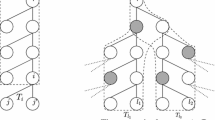Abstract
Given a graph \(G=(V,E)\) with a label set \(L = \{\ell _1, \ell _2, \ldots , \ell _q \}\), in which each edge has a label from L, and a source \(s \in V\) together with a sink \(t \in V\), the Minimum Label s-t Cut problem asks to pick a set \(L' \subseteq L\) of labels with minimized cardinality, such that the removal of all edges with labels in \(L'\) from G disconnects s and t. Let \(n = |V|\) and \(m = |E|\). The previous best known approximation ratio for this problem in literature is \(O(m^{1/2})\). We present two simple and purely combinatorial approximation algorithms for the problem with ratios \(O(n^{2/3}/\text {OPT}^{1/3})\) and \(O(m^{1/2} / \text {OPT}^{1/2})\), where \(\text {OPT}\) is the optimal value of the input instance. The former result gives the first approximation ratio which is sublinear in n for the problem, and in particular applies to the instances with dense graphs (e.g., \(m = \varTheta (n^2)\)). The latter result improves the previous ratio \(O(m^{1/2})\), as we can always assume that \(\text {OPT}\) is a super-constant.
Similar content being viewed by others
Notes
The Label Cut problem in which each edge may have more than one labels can be easily reduced to the one in Definition 1.
If \(\text {OPT}\) is bounded from above by a constant C, we can find in polynomial time the optimal solution by enumerating all possible label cuts of size at most C.
Using a shortest path algorithm (e.g., the Dijkstra’s algorithm) as the separation oracle (LP-C) can be optimally solved in polynomial time.
The algorithms presented in [21] are also two-stage algorithms; they do not depend only on the linear programming technique. So, their approximation ratios can be better than the integrality gap of (LP-C).
References
Ahuja, R.K., Magnanti, T.L., Orlin, J.B.: Network Flows: Theory, Algorithms, and Applications. Prentice Hall, Englewood Cliffs, NJ (1993)
Broersma, H., Li, X.: Spanning trees with many or few colors in edge-colored graphs. Discuss. Math. Graph Theory 17(2), 259–269 (1997)
Broersma, H., Li, X., Woeginger, G., Zhang, S.: Paths and cycles in colored graphs. Australas. J. Comb. 31, 299–311 (2005)
Chang, R.-S., Shing-Jiuan, L.: The minimum labeling spanning trees. Inf. Process. Lett. 63(5), 277–282 (1997)
Consoli, S., Moreno-Pérez, J.A., Darby-Dowman, K., Mladenovic, N.: Discrete particle swarm optimization for the minimum labelling steiner tree problem. Nat. Comput. 9(1), 29–46 (2010)
Coudert, D., Datta, P., Perennes, S., Rivano, H., Voge, M.-E.: Shared risk resource group: complexity and approximability issues. Parallel Process. Lett. 17, 169–184 (2007)
Couëtoux, B., Gourvès, L., Monnot, J., Telelis, O.: Labeled traveling salesman problems: complexity and approximation. Discrete Optim. 7(1–2), 74–85 (2010)
Fellows, M., Guo, J., Kanj, I.: The parameterized complexity of some minimum label problems. J. Comput. Syst. Sci. 76(8), 727–740 (2010)
Hassin, R., Monnot, J., Segev, D.: Approximation algorithms and hardness results for labeled connectivity problems. J. Comb. Optim. 14(4), 437–453 (2007)
Jegelka, S., Bilmes, J.: Cooperative Cuts: Graph Cuts with Submodular Edge Weights. Technical Report TR-189, Max Planck Institute for Biological Cybernetics (2010)
Jegelka, S., Bilmes, J.: Graph Cuts with Interacting Edge Costs-Examples, Approximations, and Algorithms. CoRR, arXiv:1402.0240 (2014)
Jha, S., Sheyner, O., Wing, J.M.: Two formal analyses of attack graphs. In: Proceedings of the 15th IEEE Computer Security Foundations Workshop (CSFW), pp. 49–63. IEEE Computer Society (2002)
Johnson, D.: Approximation algorithms for combinatorial problems. J. Comput. Syst. Sci. 9, 256–278 (1974)
Khuller, S., Moss, A., Naor, J.: The budgeted maximum coverage problem. Inf. Process. Lett. 70(1), 39–45 (1999)
Korte, B., Vygen, J.: Combinatorial Optimization: Theory and Algorithms, 5th edn. Springer, Berlin (2012)
Krumke, S.O., Wirth, H.C.: On the minimum label spanning tree problem. Inf. Process. Lett. 66(2), 81–85 (1998)
Menger, K.: Zur allgemeinen kurventheorie. Fundam. Math. 10, 96–115 (1927)
Monnot, J.: The labeled perfect matching in bipartite graphs. Inf. Process. Lett. 96, 81–88 (2005)
Sheyner, O., Haines, J., Jha, S., Lippmann, R., Wing, J.: Automated generation and analysis of attack graphs. In: Proceedings of the IEEE Symposium on Security and Privacy, pp. 273–284. Oakland, CA (2002)
Sheyner, O., Wing, J.M.: Tools for generating and analyzing attack graphs. In: de Boer, F.S., Bonsangue, M.M., Graf, S., de Roever, W.P. (eds.) Proceedings of Formal Methods for Components and Objects, Second International Symposium (FMCO 2003), vol. 3188 of LNCS, pp. 344–371. Springer (2004)
Tang, L., Zhang, P.: Approximating minimum label \(s\)-\(t\) cut via linear programming. In: Fernández-Baca, D. (ed.) Proceedings of the 10th Latin American Theoretical Informatics Symposium (LATIN), vol. 7256 of LNCS, pp. 655–666. Springer (2012)
Vazirani, V.V.: Approximation Algorithms. Springer, Berlin (2001)
Xiong, Y., Golden, B., Wasil, E.: The colorful traveling salesman problem. In: Baker, E.K., Joseph, A., Mehrotra, A., Trick, M. (eds.) Extending the Horizons: Advances in Computing, Optimization, and Decision Technologies, pp. 115–123. Springer, Berlin (2007)
Zhang, P., Cai, J.-Y., Tang, L., Zhao, W.: Approximation and hardness results for label cut and related problems. J. Comb. Optim. 21(2), 192–208 (2011)
Acknowledgements
We are grateful to the anonymous reviewers for their warm suggestions, which help to improve the presentation of the paper.
Author information
Authors and Affiliations
Corresponding author
Additional information
Peng Zhang is supported by the National Natural Science Foundation of China (61672323). Natural Science Foundation of Shandong Province ZR2015FM008 and ZR2016AM28, and the Fundamental Research Funds of Shandong University (2015JC006). Bin Fu is supported by NSF Career Award 0845376. Linqing Tang is partially supported by Hundred Talent Program of Chinese academy of Sciences under Prof. Angsheng Li.
Rights and permissions
About this article
Cite this article
Zhang, P., Fu, B. & Tang, L. Simpler and Better Approximation Algorithms for the Unweighted Minimum Label s-t Cut Problem. Algorithmica 80, 398–409 (2018). https://doi.org/10.1007/s00453-016-0265-1
Received:
Accepted:
Published:
Issue Date:
DOI: https://doi.org/10.1007/s00453-016-0265-1




